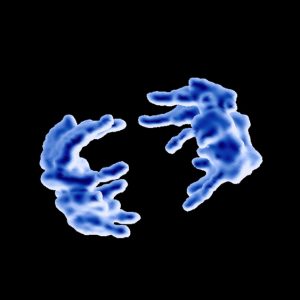Researchers shed light on shrinking of chromosomes
Late shortening of chromosomes helps cells to organise and protect their DNA during cell division

A human cell contains an enormous 1.8 metres of DNA partitioned into 46 chromosomes. These have to be copied and distributed equally into two daughter cells at every division. Condensation, the shortening of chromosomes, allows the cell to handle such huge amounts of genetic material during cell division and helps preventing fatal defects in chromosome separation. Now researchers from the European Molecular Biology Laboratory (EMBL) for the first time tracked chromosome condensation in mammalian cells over the entire course of cell division. In this week’s advanced online publication of Nature Cell Biology they report crucial new insights into timing, function and molecular basis of chromosome condensation.
What happens when chromosomes are not correctly separated and distributed during cell division we know very well; two daughter cells with either broken chromosomes or different numbers of chromosomes result and severe diseases including cancer can arise. But so far we know only little about condensation, a process crucial to the successful separation of chromosomes. Using powerful microscopes, researchers led by Jan Ellenberg at EMBL looked at living mammalian cells to find out how and when chromosomes shorten during cell division.
Condensation begins early, when the cell starts preparing for division, and the chromosomes become shorter and shorter until they are about to separate and migrate towards the poles of the cell.
“It is at this stage that textbooks say chromosomes are shortest. Then, after separating they would expand again,” says Ellenberg. “But we found something very different. Shortly after they finish separating, chromosomes actually condense even further. This makes sense, because in this way they are shortest when the physical division of one cell body into two takes place. Like this, no long chromosome arms extend over the plane of division, because that could expose the DNA to serious mechanical damage.”
The extreme condensation of chromosomes towards the end of cell division can also serve as a safety net if something goes wrong with chromosome separation in earlier phases of division. When the researchers added chemicals to the cell to block the late condensation, more separation defects appeared.
“Sometimes chromosomes get stuck and cannot be fully separated by the spindle that normally distributes them into the daughter cells,” says Felipe Mora-Bermúdez, who carried out the experiments in Ellenberg’s lab, “we think that the ‘super condensation’ at later stages helps to disentangle such chromosomes and acts as a back-up mechanism to rescue separation defects.”
The EMBL researchers found that an enzyme called Aurora kinase is crucially involved in this process. Blocking this enzyme abolishes late condensation of chromosomes. They now hope to uncover the detailed molecular mechanism underlying the late shortening of chromosomes. This could further advance our understanding of cell division and the risk factors that lead to defects in chromosome separation and their dramatic consequences.



